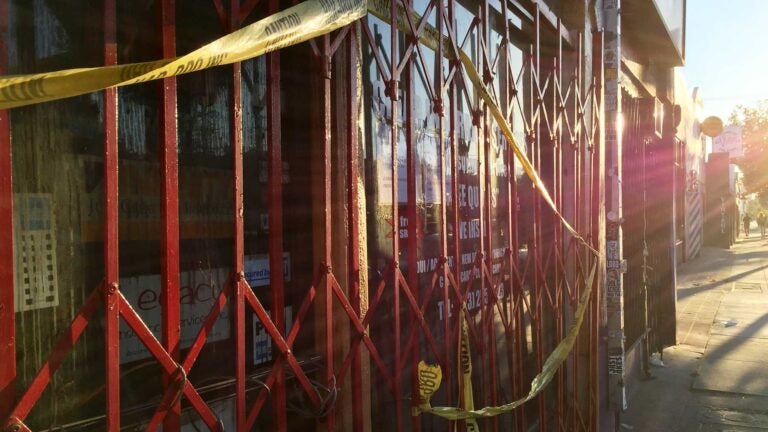
A USC study has shown that shuttered businesses, even temporarily closed ones, correlate with a spike in area crime rates. (USC Photo/Susanica Tam)
Shuttered businesses linked to a rise in property crimes
USC-led study finds that when foot traffic is down, crime goes up — even when the closed businesses were marijuana dispensaries thought to be crime magnets
Even a temporary business closure is bad news for a neighborhood, linked to a rise in some crimes outside its shuttered doors, according to a recent USC-led study.
While studying crime trends around closed restaurants and medical marijuana dispensaries, Tom Chang, an assistant professor of finance and business economics at the USC Marshall School of Business, found that some crimes increase in the area.
“It’s all about foot traffic,” Chang said. “If people are frequenting a business, then that means there are more eyes on the street, and that’s a deterrent for certain types of crime.”
The study’s findings, published in April in the Journal of Urban Economics, reinforce arguments for mixed-use development, in which residential buildings include retail spaces, Chang said. Mixed-use development is meant to increase a community’s walkability and enhance a neighborhood’s local character, he added.
Brick-and-mortar benefits
He said the findings may also underscore an important benefit of brick-and-mortar retail — enhancing neighborhood safety – although many shops find themselves at risk of closure amid the increasing popularity of internet retailers that offer competitive deals and inexpensive shipping.
For the study, Chang and co-author Mireille Jacobson of the University of California, Irvine examined the temporary closures of two types of businesses: medical marijuana dispensaries and restaurants.
Chang said his initial interest in the link between business closures and crime was stoked by a 2010 Los Angeles City Council’s attempt to address public concerns that the dispensaries were a potential crime magnet. That year, the council voted to temporarily limit the number of dispensaries that could operate.
The city grandfathered in 187 dispensaries that had legally registered three years before and permitted only 70 others. About two-thirds — 417 — were ordered to close their doors by June 7, 2010. However, after an onslaught of court cases filed on behalf of the dispensaries or patients who used them, many were quickly allowed to reopen.
Referring to statistics provided by the Los Angeles Police Department to the Los Angeles Times for its Mapping L.A. Project, Chang said he and Jacobson compared the city’s dispensary closure data to crime stats recorded within 10 days both before and after each closure. They then narrowed their focus to crimes committed within a range of up to two miles of each dispensary.
I was surprised to find that crime actually increased around closed dispensaries.
Tom Chang
“I was surprised to find that crime actually increased around closed dispensaries,” Chang said. “If the press covered all the crimes that happen outside a family restaurant, then we might think that they were crime magnets, too.”
According to the analysis, crimes increased 14 percent to 16 percent within a quarter mile of the dispensaries that were closed, and 23 percent to 24 percent within an eighth of a mile. The effect was driven by an increase in property crimes, especially thefts from vehicles.
Restaurants, too
“We wondered if this was unique to dispensaries,” Chang said. “So, we decided to take a look at what would happen with crime if a restaurant closed.”
Chang and Jacobson noted that restaurants and medical marijuana dispensaries in Los Angeles appear in similar neighborhoods.
Referring to restaurant closure data maintained by the Los Angeles County Department of Public Health’s Environmental Health Division, Chang and Jacobson narrowed their study to 888 restaurants temporarily closed sometime between Feb. 1 and Oct. 31, 2010, for major health violations — such as a mouse or rat infestation, sewage disposal problems or improper food temperatures that pose an imminent health hazard.
On average, the restaurants reopened within two days of the health violation after the county determined they had corrected the health problem.
Again, Chang and Jacobson found that crimes, particularly property crimes, within the immediate vicinity would increase. Thefts from vehicles, for instance, increased by up to 30 percent within a quarter of a mile of a closed restaurant.
‘Eyes on the street’
Explaining their findings, Chang noted that Jane Jacobs in the 1961 book, The Death and Life of Great American Cities, shared an idea that “eyes upon the street,” is an informal type of policing.
Chang noted that he and Jacobson found that neighborhoods that had few businesses to start with, and that had poor walkability, experienced the greatest spike in crime when a dispensary or restaurant closed.
“A back-of-the-envelope estimate suggests that each open retail business can provide about $30,000 a year in social benefit by deterring larcenies,” he said.
Chang wondered how these findings may translate when a nationwide trend in closures begins – such as the retail industry is now experiencing.
“With brick and mortar retail in dramatic decline, the question now is: Will the loss of those stores lead to a meaningful increase in criminal activity?” Chang said. “Our study gives us reason to suspect that could happen.”
